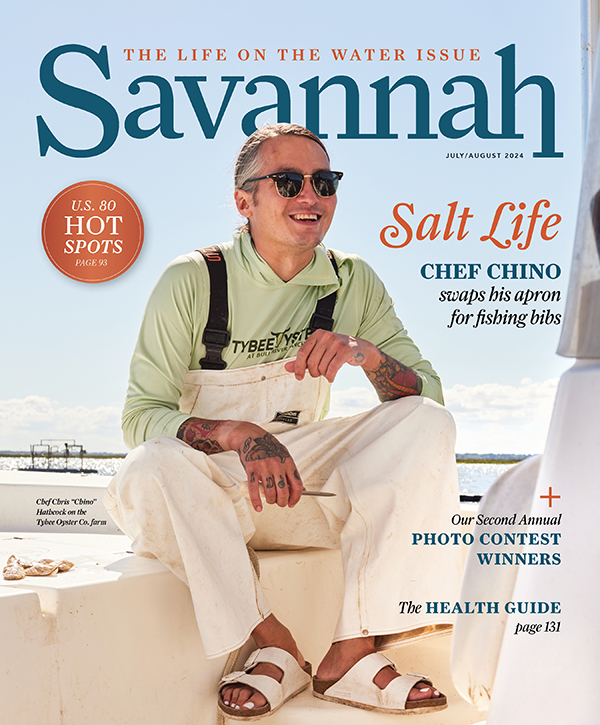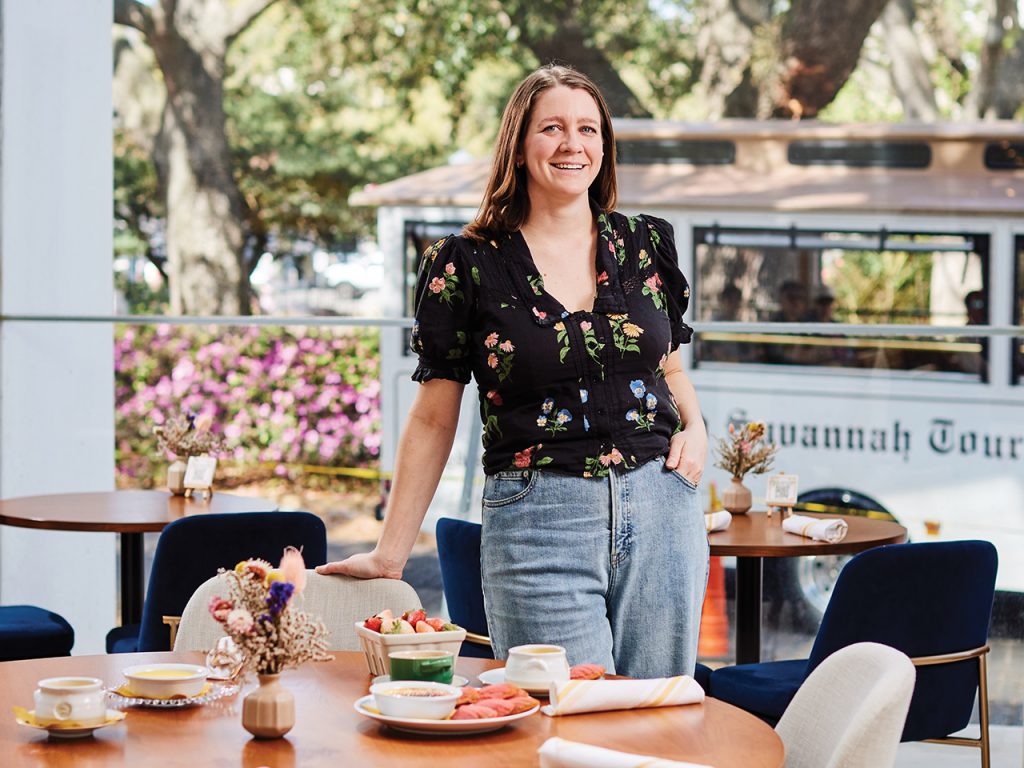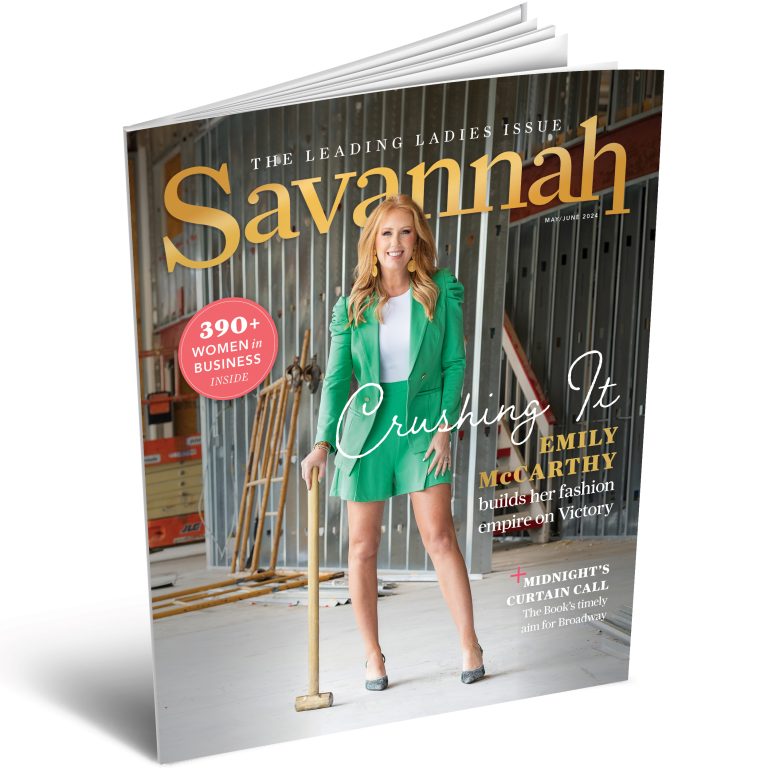She talks about what it’s like occupying the former Back in the Day Bakery space and shares her recipes for strawberry shortcake crème brûlée and madeleines
Written by LIA PICARD
Photography by MICHAEL SCHALK
ANNIE COLEMAN knew she’d return to the Lowcountry one day. The Beaufort, South Carolina, native was living in Washington, D.C., when she and her husband realized that they wanted to plant roots farther south, and an opening with FARM Hospitality Group — helmed by chef Brandon Carter, who is also responsible for local favorites FARM, Common Thread and Strange Bird — was the ticket.
After serving as chef de cuisine for Wildflower Cafe inside the Jepson Center for the Arts, Coleman recently opened Flora and Fauna in the former Back in the Day Bakery location where she is now leading the French-inspired bakery and seasonally driven kitchen along with a team of female leaders, including chef de cuisine Tyler Kenny (formerly executive sous chef of Common Thread) and sous chef Shannah Price (formerly sous chef of FARM).
Here, Coleman talks about the new cafe, her time in Paris and life in Savannah.
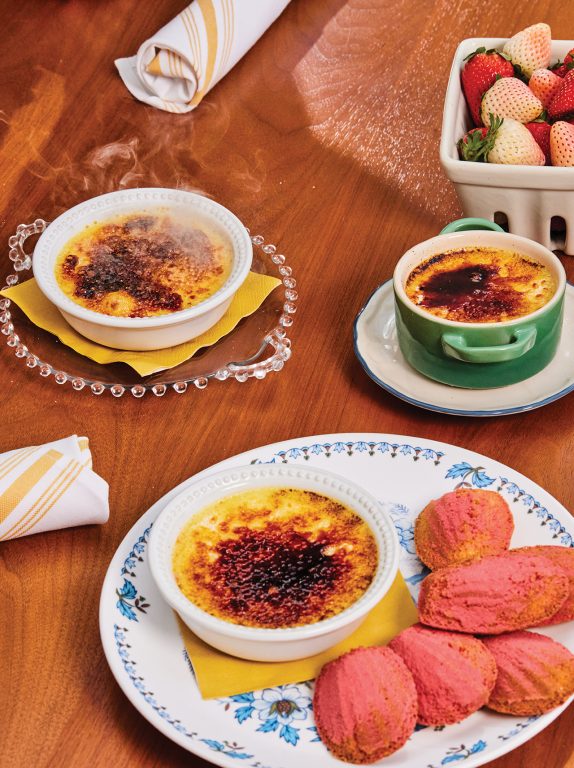
On Flora and Fauna
It’s a bakery and an all-day place to eat. It’s an intimate space with about 40 seats, and we serve breakfast, lunch and dinner daily and brunch on the weekends. I come from a pastry background, and I’m very excited about the bakery portion. We have croissants and a large bread program, as well as breakfast pastries like danishes and mini pies. Of course, we’re going to honor [former owner of Back in the Day Bakery] Cheryl Day’s incredible biscuits here.
On opening in the former Back in the Day space
It’s very intimidating; I’m not going to lie. I just have enormous respect for what Cheryl and [her husband] Griff have done. It’s not something I imagined happening! One day I came by to reintroduce myself to her, and she was like, “I know who you are. I’ve been talking to Brandon [Carter] about y’all coming in here.” So it’s just really big shoes to fill. But it feels good to know she has faith in us, and I know that she was really careful with who she chose to take over the space, so that’s a huge honor.
On using locally sourced grains
I’ve been playing with what I call “Carolina multigrains.” I started with grains from Rollen’s Raw Grains in Hardeeville, South Carolina. I use Rollen Chalmers’ oats, rice and grits and make a multigrain out of them. I tend to use flours from Anson Mills, in Columbia, South Carolina, but we’ll be exploring other mills in the region as well.
On moving back to the Lowcountry
I always planned on coming back, eventually. Growing up, I wasn’t a kid who thought I had to get out of my small town. I grew up appreciating the area that I was lucky enough to come up in. My family has been [on the Southeastern coast for] a long time, and my mom and grandmother really ingrained in me a love and appreciation for this area and everything it has to give.
On studying in Paris
I had wanted to go to culinary school in Paris since I was in high school. That was the only reason I took French. But once I got there, I was [still] amazed by how much I soaked in. I just loved the lifestyle and the tendency to just slow down to savor and enjoy things more. That’s also something that I see in Savannah. I feel like people here are able to slow down and appreciate what’s around them.
On living in Savannah
I love it. I thought about moving to Savannah so many times after college and after coming back from culinary school. But it was kind of a surprise to land here. We had talked about moving to Charleston for so long, but Savannah’s always been in the back of my mind, and it feels like there’s a little bit more space here. Savannah has these tight-knit communities, and that’s where I’ve always felt like I thrived, and those are the spaces that I’ve always enjoyed the most. I like to find a neighborhood and just ingrain myself as much as I can. Our neighborhood, Live Oak, [just south of downtown,] is incredible. Our neighbors are great, and we’ve very quickly found so many wonderful people and places to spend our time. I haven’t regretted it for a moment.
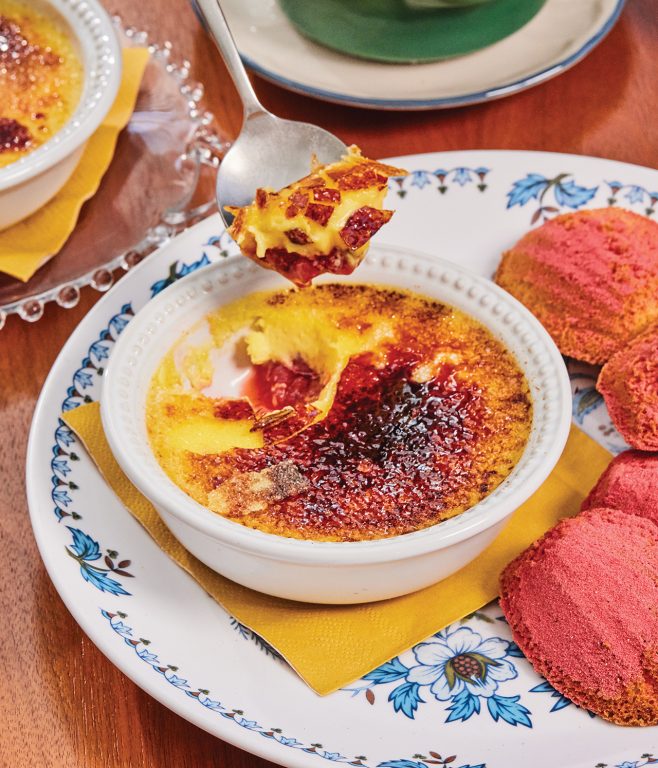
“I was so enthralled by crème brûlée growing up that my parents got me a kit complete with ramekins and a mini butane torch. It’s still one of my favorites and a go-to when I see it on a menu. Why not combine it with a springtime favorite?”
— Annie Coleman, Flora and Fauna
Strawberry Shortcake Crème Brûlée
Yield: 6 Servings
2 cups diced or mashed strawberries
1/4 cup St-Germain elderflower liqueur
1/2 cup plus 2 tablespoons sugar
1 pint heavy cream
1/3 cup whole milk
5 egg yolks
1 whole egg
1/4 teaspoon kosher salt
1/2 vanilla bean
Preheat the oven to 300 degrees Fahrenheit. In a saucepan, combine 5 tablespoons sugar, St-Germaine and strawberries. Cook over medium heat, making sure to stir occasionally so the fruit doesn’t scorch. Once the liquid is nearly cooked off, remove from heat and add the lemon juice. Disperse into six ramekins and put into the fridge to chill.
Combine the cream, milk and just a sprinkle from the 1⁄2 cup of sugar in a medium pot. Slice open the vanilla bean, use the dull side of the knife to scrape the seeds out and add seeds and pod to the cream mixture. Bring just up to a boil then remove from heat. Allow the vanilla bean to steep for 30 minutes, then remove the pod and squeeze all the liquid out into the cream mixture and return to a boil.
Once the cream is hot again, whisk together the egg yolks, whole egg, the remaining sugar and salt in a medium heat-proof bowl. Add the hot cream to the mixture one tablespoon at a time until the egg mixture is warm to the touch, then slowly stream in the rest while stirring.
Bring a quart of water up to a boil. Transfer batter into a pitcher. Place ramekins into a casserole dish. Hold a spoon upside down over the jam so the tip of the spoon is touching the side of the ramekin. Carefully pour the batter onto the back of the spoon. Fill each ramekin evenly with the batter.
Place the casserole dish into the oven and pour hot water into the casserole so it reaches halfway up the sides of the ramekins. Bake for 30 minutes or until the custard jiggles uniformly and the center is not liquid. (If you have a probe thermometer, the interior temperature should be 170-175 degrees Fahrenheit.)
Remove from the oven and carefully move the custards onto a tray. Chill for at least 2 hours, preferably overnight.
To brûlée: Sprinkle a thin but even layer of sugar over the custard. Caramelize the sugar with either a kitchen torch or by placing it under a boiler until all the sugar is melted and begins to color.
Madeleines
Yield: 20-30 madeleines (depending on pan size)
9 tablespoons butter
1 cup sugar
2 large eggs
1/4 cup light corn syrup or honey
3/4 cup plus 1 tablespoon cake flour or all-purpose flour
1 teaspoon baking powder
1/8 teaspoon kosher salt
Melt butter and allow to cool to just above room temperature. Mix together flour, baking powder and salt in a bowl and set aside.
In a mixer with a whisk attachment, mix sugar, eggs and corn syrup. Once it’s airy and nearly white, drop the speed to low and slowly add in the flour mixture. When it’s barely mixed, stream in butter. Finish mixing by hand with a spatula. Allow batter to chill in the fridge for at least 2 hours.
While the batter chills, butter and flour a madeleine baking pan and toss in the freezer for a quick chill.
Preheat the oven to 350 degrees Fahrenheit. Spoon batter into chilled pan to fill the cavities halfway.
Bake for 10-15 minutes or until a knife comes out clean. Remove from the pan immediately after baking. Serve fresh from the oven.
